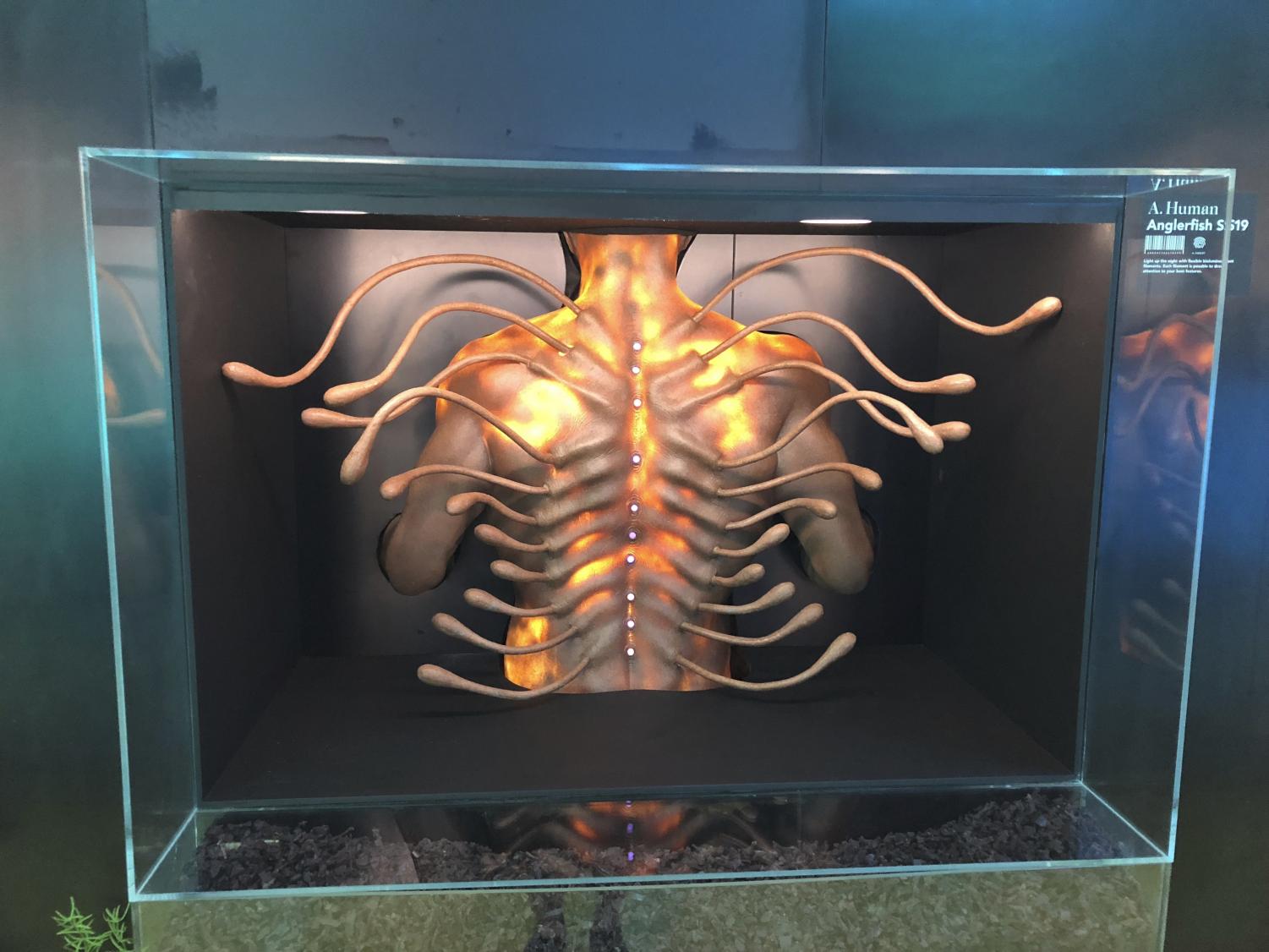NYFW exhibit touches on body modification
September 17, 2018
Fashion Instagram and Twitter were abuzz this past week for New York Fashion Week. While Nicki Minaj and Cardi B’s not-really-fight took center stage, Simon Huck’s
“A. Human” was the trending surprise that captured audience fantasy and imagination. “A. Human” is part performance, immersive exhibit, and part social media ploy. It is designed like a museum exhibit, and features unique body modifications and bizarre depictions of humans, such as persons growing out of soil (think Tyler the Creator in Kali Uchis’ “After the Storm” music video, if it had been directed by Guillermo del Torro), several body parts are depicted, such as webbed hands (presumably already trademarked by Michael Phelps), and a high-heel surgically morphed with a foot. Huck’s piece gained popularity following several high-profile fashion celebrities posting images and short videos of their temporary body modifications and implants.
Kim Kardashian showcased a coral- like, flesh-colored, pseudo implanted choker necklace with LED lights embedded beneath even more makeup than usual. Tan France, of the binge-fame Netflix series “Queer Eye,” donned a Tudor neck ruffle “implant” draped across his nape, that looked part flesh-colored octopus tentacle, and part crystal chandelier— quite the airplane neck pillow. Twitter troller-of-the-trolls Chrissy Teigen showed off implanted wings on her chest that looked as if she took a shower with an awful Afflicted t-shirt on, only to learn it was a massive temporary tattoo this whole time. The purpose of front-facing wings is not revealed, and it seems Chrissy would have no line-of-sight if they worked. Several other celebrities signed on to this “futuristic” fashion experience.
The “A. Human” exhibit exemplified the frivolity of the week (perhaps to a lesser degree than Nicki versus Bardi’s shoe), as well as the field of high fashion in and of itself. I was entertained at the thought of Kim’s LED necklace being a mood ring (does blue mean “help me, Kanye is Kanye-ing again!”) and admittedly I found the body modifications fascinating and perversely alluring.
With the appreciation of frivolity in fashion in mind, I question Huck projecting this piece as representative of future potential in fashion. The idea of surgical body modifications has its place on the runway, and these wild departures from normalcy are a welcome departure from bland make-up design. And while frivolity can be fun and pleasurable, there are many people who use body modifications and implants as more than just their fashion, but also as an integral part of their identity. Room ought to be made for transgender individuals who face regular harassment and violence for their bold, brave and beautiful body alterations.

The wealthy, cis-normative body modifications of “A. Human” is not representative of worthwhile imaginative future for the many people who have or need gender affirmation surgeries, such as male-to-female breast augmentations, female-to-male chest reconstruction surgery, or vaginoplasty. While Marco Marco’s runway show this year used only trans models, which opens the doors of countless important conversations on trans identity and was a tremendous and sexy celebration of representation for a distinctly marginalized group of people, it did not focus on the specific differences and modifications that trans people often have. Perhaps instead of LED neck lights, tech-fashion designers could consider the beauty of puberty blockers, and other hormone therapies that increase testosterone or estrogen. I recognize in saying all this that the Kardashian fashion-dynasty is in conversation with trans-visibility thanks to Caitlyn Jenner, although her particular contribution to the trans community seems to be more focused on Republican acceptance of her individually, as opposed to relevant issues like access to health care, bathrooms and basic human rights…
“A. Human’s” depiction of body augmentation as a revelatory imaginative future is not only disrupted in the history and present state of transgender fashion and body presentation/representation, but also should be read in conversation with disability visibility. The glowing LED highlight of Kardashian’s neckline is rendered meaningless considering the lack of fashionable projects for genuinely useful technological innovations, such as hearing aids, or other assistive technologies. Can these devices be runway-dazzling, depicting a future of wild imagination, beautiful abnormality, and radical inclusion? Teigen’s apocryphal front-facing wings seem uninspired in comparison to the all-terrain wheelchair, gait trainers, or back brace. Could we imagine a future where accessibility is angelic, and tools of movement are regarded as the marvels that they are?
In 2017 Moscow Fashion Week, a runway show featured a group of wheelchair models, and as stated earlier, this year Marco Marco’s runway show made history and headlines for only working with trans-models. As fashion companies and designers continue to explore the future of fashion, body modifications and cyborgian implants, an important and historic vanguard should be reached out to. Transgender and disabled peoples have led the way in these forms of public dressing and personal beautification for generations. People with lived experiences of pushing forward our understandings of personhood, what bodies could be, and what technologies can enhance our lives are necessary for conceiving the useful and frivolous potential future of fashion, tech and abstraction.
